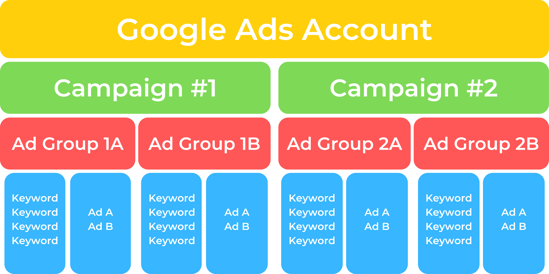What Is Pay-Per-Click Advertising?
Pay-per-click (PPC), also known as cost-per-click (CPC), is an online advertising strategy where an advertiser pays a publisher, like a search engine, every time an advertisement is “clicked” on. This method ensures advertisers only pay for ads that produce a click-through rate instead of paying to place the ad.
Main Platforms
PPC models are typically offered by search engines like Google and Yahoo! or social networks like Facebook or Twitter. Here are the three most common PPC advertising platforms.
Google Ads
Google Ads is by far the largest pay-per-click platform on the internet. Since its launch in 2000, Google Ads has gone through several iterations. In the past 17 years, it’s been able to grow to meet the needs of the entire spectrum of companies, from mom and pop shops to Fortune 500 corporations.
Microsoft Advertising
Microsoft Advertising plays a similar role as Google Ads but for the Microsoft and Yahoo! networks. The platform primarily uses key-word based advertising and search partners.
Facebook Ads
Facebook’s Ads Manager allows you to create your own PPC ads from within the site. These ads can vary from standard photos to carousel ads (advertising many different links within the same ad).
Once created, these ads can be dragged and dropped into several locations on the Facebook site, including the sidebar, desktop or mobile newsfeed, and audience network.
Since Facebook also owns Instagram, you can choose to have your Facebook ads displayed on your user’s Instagram feed as well.
How Does PPC Advertising Work?
PPC advertising is far more straightforward than it seems. In order for ads to appear on the search engine results page (SERP), the advertiser must enter into an Ad auction. Now, ad auctions aren’t as easy as paying more than your competitors. Ad auctions are automated processes used by search engines to determine the relevance and validity of the ads that appear on their SERPs.
Pay-Per-Click Models
Typically, pay-per-click advertising rates are determined using either the flat-rate or bid-based advertising models.
Flat-Rate Model
The flat-rate pay-per-click model is when an advertiser pays a publisher a fixed rate for each click. Keep in mind that publishers tend to charge different PPC rates depending on the ad placement. Publishers are typically open to negotiations, especially if the advertiser offers a long-term or high-value contract.
Bid-Based Model
The bid-based model is when each interested advertiser makes a bid of the maximum amount of money they’re willing to pay for the ad placement. All interested parties are then entered into an auction that is triggered whenever a visitor triggers the ad spot.
The auction winner is usually determined by the rank of the money offered rather than the total amount. The ad rank is determined by both the amount of money offered as well as the quality of the ad campaign. So quality really is better than quantity.%202.png?width=474&name=Untitled%20design%20(54)%202.png)
The Importance of Keywords
Ad placement is only worth it if you choose the right keywords. Imagine that your company specializes in water sports equipment. Consumers who want to buy a paddle board, surfboard, or water skis might type water sports into their search bar. The moment the user hits search, the search engine performs the algorithms that ad auctions are based on to determine which ad groups are displayed, the order they’re in, and which advertiser's content is displayed.
It’s important to choose relevant keywords for your business in order to get ROI from your ad spend since you pay for each click. Try using a keyword tool to help find the right keywords that will lead to a higher click-through rate (CTR) drive sales and conversions, all without breaking the bank.
Negative Keywords
Negative keywords are a method of preventing your ad from being shown in search results that are related to your word but might not lead to conversions. For example, maybe you're advertising for a new electric razor. Unfortunately for you, Razor is also a popular brand of scooter. Negative keywords allow you to prevent your ads from showing up in search results for razor if it’s paired with the word scooter. This way, you don’t waste your money or the user's time. Negative keywords are extremely useful, especially if your daily budget is on the tighter side..png?width=636&name=Untitled%20design%20(52).png)
How to Optimize Your Pay-Per-Click Ads
PPC marketing, if used correctly, can be a cost-effective way to increase brand awareness, conversion rates, and SEO. But like any marketing strategy, it takes time and effort to do it right. Several factors can affect your PPC costs, including relevant keywords, ad and landing page quality, and account structure.
Relevant Keywords
Are your search terms optimized for your primary demographic, and are they driving traffic back to your website?
Ad and Landing Page Quality
Google typically awards the best ad placement as well as the lowest costs to the business that displays the highest quality score and prioritizes their UX. Take a look at your Google Analytics and CTA to gauge if your ad copy resonates with your target audience.
Account Structure
Think of your pay-per-click account as a house. The first step is to build a strong foundation.

Campaign Type
What is your advertising goal? The right campaign type for your eCommerce business depends on your answer. Typically companies start with search ads, but if you're trying to generate awareness for a completely new brand or product, display ads might be the best option. Can’t choose? That's okay. You can create multiple campaign types to achieve various goals.
The next step is determining your campaign settings. Who are you trying to target, and how are you trying to find them? Once you know that, you can edit your campaign based on:
- Location Targeting
- Language Targeting – Any language customers speak
- Bid Strategy – Automatic vs. Manual
- Budget
Ad Group
What are ad groups? They’re the step after campaigns in your account structure. Ad groups create the structure within each campaign, are organized by theme, and control keyword association.
How big should an ad group be? The typical ad group should be between 7-10 total ad groups per campaign. There should only be 2-3 ads within each of those ad groups. And each ad should have a max of 20 keywords. Every campaign is different, so there will always be exceptions to the rule, but for the most part, these are the best practices for a successful ad group.
Below ad groups are keywords and ad copy. Make sure your keywords work for you. Try starting with modified broad match keywords that show deliberate intent. For keyword suggestions, check out tools like SEMrush.
When it comes to your ad copy, make sure you're setting yourself up for conversions and creating a solid A/B testing system. For more info on how to create an effective A/B testing strategy, check out Hubspot's guide.
How Much Does PPC Cost?
So how much does PPC really cost? Well, that depends on the keywords used. PPC campaigns are based on keywords and their popularity. The more in demand a keyword is, the more expensive it is.
PPC campaigns are based on keywords. Some keywords cost more than others. For example, an ad that uses a keyword like “earbuds” is going to be a lot more expensive than a keyword like “Phillip Stein.” This is because more advertisers are bidding on “earbuds” than “Phillip Stein.”
The cost of a PPC campaign is also in part determined by you. Most ad networks provide you with the option to set a daily budget to monitor expenses. For example, you might run a campaign with a budget of $100 per day. Once you’ve met that limit, the ad network will shut off your ads for the rest of the day.
Conclusion
Pay-per-click advertising can be an extremely cost-effective way to get the word out about your brand, especially if your company lacks a surplus of upfront funding. Doesn’t seem like the right fit for your business? Don’t worry. Check out our blog on Google Ads to discover more ways to market your company.
About
Read for insights
Find ideas for your business, gain leadership, stay on top of the strategic trends of your market to beat your competition.
Popular
Top Articles
Categories
topics on the blog
Recommended articles
How to Make a Media Kit
What is a Media Kit? A media kit, also known as a press kit, is a document that businesses give to journalists and media outlets before an...
Read moreWhat is Brand Voice? [And How to Create One]
What is Brand Voice? A brand voice is the unique personality a brand takes on in all of its communication channels. And it’s not just about...
Read moreA Beginner's Guide to the Product Development Process
What is Product Development? Product development is the process of creating a new product or updating an existing product from idea to...
Read more



